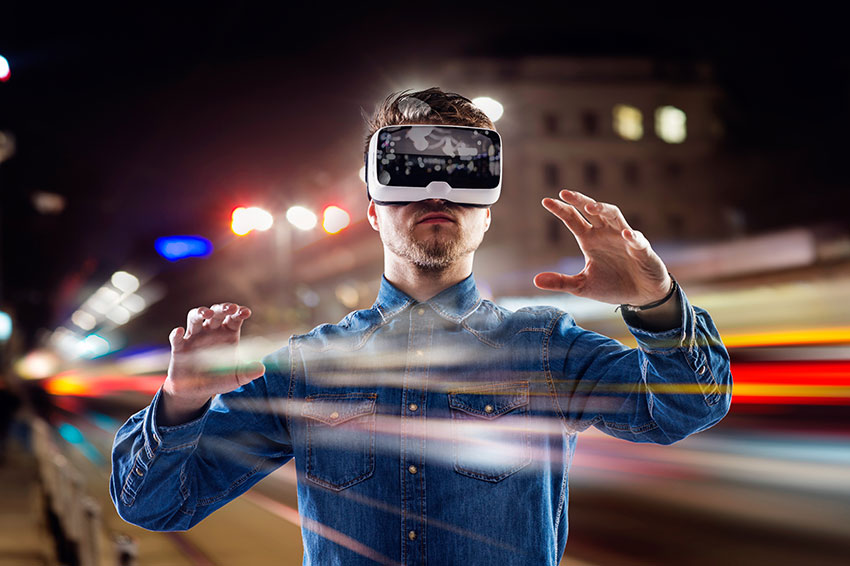Business Reality

Digital transformations redesign every facet of modern business and have recently progressed from a fanciful trend to a fundamental element of successful business strategy. New technologies have allowed content creators to connect and communicate with customers in new and exciting ways. No matter how turbulent the year seemed when it came to political affairs or global conflicts, 2016 was an inspired year for Augmented (AR) and Virtual Reality (VR), and to some extent, last year could be thought of as the year marking the tech’s ‘coming of age’.
Though closely linked, VR is centered on inventing an entirely digital world while AR is about enriching reality with digital content. VR is synonymous with hardcore gamers; the intense tech heads who are more than happy to wear a huge set of black goggles and network with people, places, and things that aren’t actually there. On the other hand, AR combines reality with virtual reality making it more accessible and user-friendly for the majority of people and businesses.
You don’t need to be a gaming geek however to have noticed the success of the Pokémon Go AR App. Also, Snapchat became Snap, Inc. knowing it was onto a good thing, giving its users a simple AR extension of the social application in the form of Snapchat Spectacles. These technologies, once limited to the gaming sector, are hitting the mainstream, making them easier to implement in other industries. By integrating VR and AR technologies into businesses, the ways through which people experience purchases, building, buying and selling are changing. AR and VR are truly the transformers of future business. Lego, for example, implemented AR kiosks into their retail locations, so customers could scan the kit and visualise what the finished product looked like before buying it. Now, that’s a winning marketing strategy.
Every decade an important, innovative computing platform arrives on the scene.
These applications may have been seen as gimmicky advertising ploys in the past, but clever companies are looking to them to re-examine their business capability and to encourage brand recognition. Every decade an important, innovative computing platform arrives on the scene. First we had the internet, then personal and mobile computing and, come 2017, welcome immersive computing. With Google’s DayDream VR and Project Tango ready for mass consumption, we can expect an explosion of AR- and VR-ready smartphones this year.
VR app development is also partly responsible for the growth of AR, and these technologies have now advanced to a stage where businesses can make use of them to strengthen their reputation and increase revenue. Fortunately, there are companies such as 3D Interactive Sthlm AB that specialise in visual communication of products and services, to help your business realise the dream.
Business-focused AR apps are already creating an impression across a number of markets. Many sectors including the property, banking and telecom industries are changing fast because of innovations in technology that make it feasible to visualise and experience a property, product or place without in reality being there. Soon, there will be no need to meet an estate agent and waste time and energy looking for houses. With the help of these technologies you will take a virtual tour of any home that you are considering, without even leaving the house you are in.
Imagine the possibilities for the medical sector when medical students can practice surgeries in a low stakes setting and the construction and entertainment industries are also set to gain. The ability for customers to interact with 3D models has proven to be a great ROI for businesses. These technologies also open up opportunities for product or service specific PR and branding across the board, so what are you waiting for?
While consumer awareness of AR is still relatively low, and it may still hold a ski-fi, futuristic connotation to some, this technology will only get more and more mainstream in the coming months. The end goal is to target consumers through focused, branded experiences. As the connected generation continues to develop, electronics companies and retailers will be looking to further engage consumers through VR and AR. Visual communication is the way forward and companies like 3D Interactive Sthlm AB are leading the way, having facilitated several customers in Sweden and abroad in developing AR solutions to push sales and increase profitability.
Before, AR was firmly placed in the space-age ‘it may never happen’ box. However, it has gone from being a pipe dream to a legitimate reality in just over a century. Now, with consumers and brands becoming more aware and interested in its existence, the hardware is catching on and it is time to incorporate it into your business. The use of AR and VR in businesses can offer customers a rich user experience which is pretty rewarding from the point of view of the consumer. So, is it really the future? Absolutely, it is. Now that companies have seen the benefits of AR, with its limitless possibilities and customer focused ethos, things are getting interesting. The revolution has only just begun.

